
Flows & Liquidity
What do markets expect ahead of the US jobs report?
- Market pricing appears to suggest little US recession risk priced in equities and credit while bond and commodity markets seem to price in more elevated recession risk.
- In terms of positioning, we see elevated positioning in equities whether we look at global non-bank investors at the aggregate level or at the investor level, with the exception of momentum-based investors who appear to have more modest longs in the US but are closer to neutral in other regions.
- Bond positioning does appear somewhat long overall, whether we look at overall non-bank investors or at the institutional investor level. Given that market pricing already looks for Fed funds rates at around 3% by end-2025, which could broadly be characterised as ‘neutral’, long duration positions from here arguably imply more elevated recession risks as rates would need to decline by more than forwards.
- Depressed commodity positioning is also consistent with higher recession risk.
- How large are the rebalancing flows from leveraged ETFs?
- There is high anticipation for the August US jobs report to be released this coming Friday as it would likely be key for investors in terms of gauging US recession risk. The consensus among economists is for the US jobs report to reinforce the soft landing narrative as they look for the US unemployment rate to tick down to 4.2%, from 4.3% in July, and for non-farm payrolls to rise by 165k following a rise of 114k in July. Therefore, for the US recession narrative to re-emerge among economists a non-farm payrolls number perhaps below 125k would be needed along with an unemployment rate at 4.3% or higher.
- How are investors positioned ahead of the release of the August US jobs report? To answer this question we update the cross-asset positioning analysis from our previous publication on August 7th. Starting with recession probabilities implied by asset prices, we find that, in line with the consensus among economists, the soft landing scenario is embedded in equity and credit markets. In contrast rate markets appear to be leaning more towards the recession scenario. These recession probabilities implied by asset prices are shown in Figure 1 and Figure 2. To construct these recession probabilities we compare the current cycle peak-to-trough moves in various asset prices to those seen during previous recessions. The higher cyclicality and interest-rate sensitivity of small caps (due to their greater reliance on floating rate debt) makes them a more suitable place to gauge cyclical risks. And Figure 1 suggests that the current pricing of US large or small caps embeds a rather low probability of recession relative to that implied by US rate markets. This is also true for Euro area assets in Figure 2 where equity and credit markets price in a significantly lower probability of recession relative to euro rate markets.
Figure 1: Probability of a recession as it was priced on Sep 4th 2024 across US equity, credit and rate markets
In %.
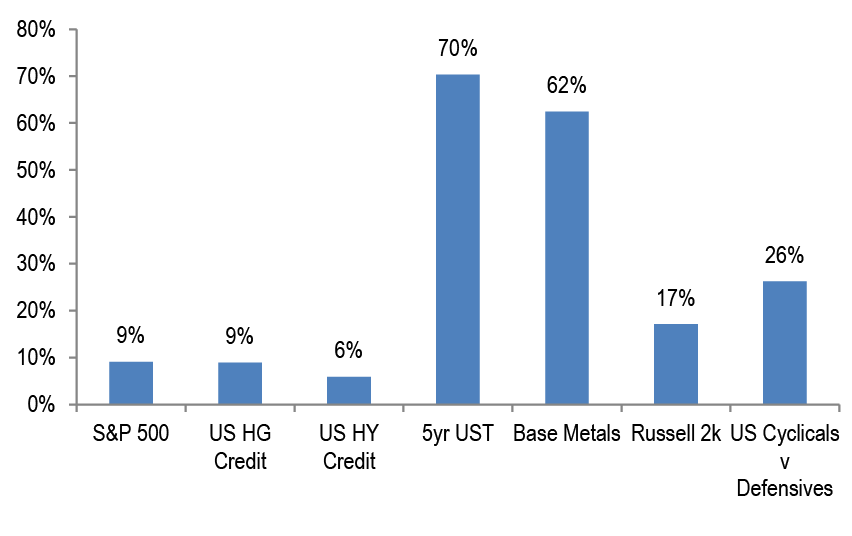
Source: Bloomberg Finance L.P., J.P. Morgan.
Figure 2: Probability of a recession as it was priced on Sep 4th 2024 across Euro equity, credit and rate markets
In %.

Source: Bloomberg Finance L.P., J.P. Morgan.
- What does the recent equity and bond market’s reaction to economic news tell us about investor positioning? To assess the market reaction to economic news, we take as our starting point the economic releases incorporated in our US and Euro EASI indices and calculate for each release the z-score of surprises (actual – survey median) / (std. dev. of past surprises) and the z-score of changes in the MSCI AC World Index for that day. We calculate separately the average beta (or the ratio of the z-score of MSCI AC World Index changes over the z-score of economic surprises) for positive and negative news, take the difference between the two and use an exponentially-weighted scheme to give greater weight to more recent observations. This indicator shown in Figure 3 represents an indirect positioning metric, and arguably positive (negative) values suggest equity investors have found themselves longer (shorter) equities than they would like to be given the surprises in the economic data flow, rather than necessarily long (short) relative to benchmark. Figure 3 suggests that following the past weeks’ market rebound and the reaction to recent economic news, equity investors found themselves less long equities than at the beginning of August. That said, while this indicator had turned largely neutral at the turn of the month this appears to have been temporary and the beta is again in positive territory at around 0.2, carrying some echoes of the 2022 backdrop when the prevalence of equity longs left equity investors finding themselves persistently longer equities than they would have liked to be at the time.
Figure 3: Difference in the beta of the MSCI AC World returns to positive US and Euro area economic news minus beta to negative news
42 day exponential weighted moving average (lambda = 0.98).

Source: Bloomberg Finance L.P., J.P. Morgan.
- The equivalent indicator for bonds is shown in Figure 4. Bond investors appear to have found themselves persistently shorter duration than they would like to be given the surprises in the economic data flow since May 2024, similar to 4Q23 or to the summer months post the June 2022 Fed meeting, although there appears to have been some normalisation into the turn of the month. Again the question is where this indicator settles. If, as it currently appears, it settles in decent negative territory at a beta of around -0.40 or so, that would represent a return to the Oct 2022-April 2023 period when the prevalence of duration shorts left bond investors persistently shorter duration than they would have liked to be at the time.
Figure 4: Difference in the beta of the average of 10y UST and 10y Bund yields to positive US and Euro area economic news minus beta to negative news (including inflation news)
42 day exponential weighted moving average (lambda = 0.98).

Source: Bloomberg Finance L.P., J.P. Morgan.
- What about our asset allocation metric at a global level? These allocations are shown in Figure 5 to Figure 8 for equities, bonds, cash and commodities. Figure 5 depicts the implied equity allocation of non-bank investors globally as a percentage of their total holdings of equities/bonds/cash (cash is proxied by the stock of M2 money supply). The dotted lines in Figure 5 depict averages. The blue dotted line depicts the average post-2015 which, in our opinion, is more relevant as it captures the “new equity culture” that emerged among households over the past decade due to zero commission trading and access to leverage. While Figure 5 suggests that there has been some retrenchment in equity allocations in recent weeks, not so much because of the decline in equity prices but mostly because of the sharp increase in bond allocations ( Figure 6) , the current equity allocation at 46.5% remains significantly above post-2015 average levels. On our calculations for the equity allocation to return to post-2015 average levels, equity prices would have to decline by a further 8% from here. For comparison, in the October 2022 or October 2023 lows, the equity allocation had declined to below the post-2015 average of 44.5%. In addition, the cash allocation in Figure 7 remains extremely low by historical standards posing vulnerability to both equities and bonds going forward. For bonds, the allocation has also increased and looks in line with long-term averages, but as we have argued before we believe the higher interest rate environment pre-Lehman is a more relevant comparison at the current juncture than the subsequent period of very subdued interest rates. Relative to the pre-Lehman period, non-bank investors appear rather overweight bonds. Commodity allocations have fallen below average (neutral) levels suggesting that commodity markets price in more recession risk than equity markets.
Figure 5: Implied equity allocation by non-bank investors globally
Global equities as % total holdings of equities/bonds/M2 by non-bank investors. Dotted lines are averages.

Source: Bloomberg Finance L.P., J.P. Morgan.
Figure 6: Implied bond allocation by non-bank investors globally
Global bonds as % total holdings of equities/bonds/M2 by non-bank investors. Dotted lines are averages.

Source: Bloomberg Finance L.P., J.P. Morgan.
Figure 7: Implied cash allocation by non-bank investors globally
Global cash held by non-bank investors as % total holdings of equities/bonds/M2 by non-bank investors. Dotted lines are averages.

Source: Bloomberg Finance L.P., J.P. Morgan.
Figure 8: Implied commodity allocation by non-bank investors globally
Proxied by the open interest of commodity futures ex gold as % of the stock of equities, bonds and cash held by non-bank investors globally.
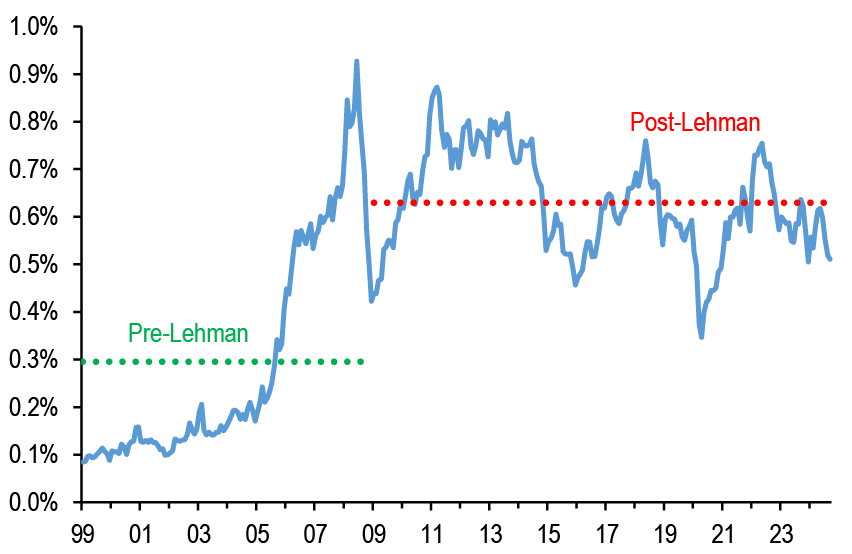
Source: Bloomberg Finance L.P., J.P. Morgan
- What about our various signals for positioning by different types of investors across asset classes? Turning first to equities, Figure 9 shows the average of the z-scores of the longer- and shorter-term signals for major equity indices in our trend-following investor framework (see Tables A3 and A4 in the Appendix for further detail). It shows that the signals were in extreme positive territory mid-July and that the signals had effectively turned neutral intra-day on Aug 5th, suggesting a rather severe unwind of long positions by momentum investors. The average z-score for the S&P 500 currently stands at around +0.9, suggesting momentum-based investors have elevated but not extreme longs in US equities. For the Eurostoxx 50 and MSCI EM, the z-scores currently stand at around +0.3, suggesting rather modest longs overall, while for Nikkei the signals turned modestly short with a z-score of -0.2 after the sell-off on Sep 4th.
Figure 9: Momentum signals for major equity indices
Average z-score of Short- and Long-term momentum signal in our Trend Following Strategy framework shown in Tables A3 and A4 below in the Appendix.

Source: Bloomberg Finance L.P., J.P. Morgan.
- What about speculative investors more broadly? Figure 10 shows the net long positions in US equity futures of asset managers and leveraged funds in the CFTC data as a share of total open interest. It suggests that while there has been a modest reduction in net longs from the recent peaks in mid-July of around 31% of open interest to around 27% currently, this is still at the upper end of its historical ranges. Moreover, retail investors have continued to pour money into equity funds through both July and August, with YTD net inflows into equity ETFs and mutual funds standing at just over $390bn.
Figure 10: Positions in US equity futures by Asset managers and Leveraged funds
CFTC positions in US equity futures by Leveraged funds and Asset managers (as a % of open interest). It is an aggregate of the S&P500, DowJones, NASDAQ and their Mini futures contracts.

Source: CFTC, Bloomberg Finance L.P. and J.P. Morgan.
- In other words, consistent with the picture for non-bank investors’ equity allocations more broadly, institutional and retail investors appear to hold rather elevated equity exposure heading into this week’s labor market report.
- What about bonds? Figure 11 shows the average of the z-scores of the longer- and shorter-term signals for 10y USTs, Bunds and JGBs. These momentum signals had shifted to signal rather elevated longs in USTs and JGBs on Aug 5th of around +1.3 standard deviations, and a rather more modest +0.4 for Bunds. Since then, the signals have moderated to around +0.5 for 10y USTs and JGBs and effectively 0 for Bunds, suggesting momentum-based investors are modestly long duration in the US and Japan and largely neutral in the Euro area. To look at speculative investors more broadly, Figure 12 shows our futures positioning proxy for 10y UST futures, based on the cumulative daily absolute changes in open interest multiplied by the sign of the price change. It suggests that there has been an increase in the long positions since end-July. Turning to real money investors, Figure 13 shows the net percentage of longs reported by respondents to our US Treasury Client Survey and the deviation in US duration from target by multi-currency investors in our European Client Survey. It suggests that there were some reductions in net longs by US clients over the past two weeks, and while US duration positions in the European client survey have been little changed, both surveys suggest, if anything, that duration positions are not as elevated as they were toward the end of 2023. This suggests that while there are some pockets of long duration exposure, overall positions do not appear very elevated.
Figure 11: Momentum signals for 10y USTs, Bunds and JGBs
Average z-score of Short- and Long-term momentum signal in our Trend Following Strategy framework shown in Tables A3 and A4 in the Appendix.

Source: Bloomberg Finance L.P., J.P. Morgan.
Figure 12: Futures position proxy for 10y UST futures (TY1)
In thousands of contracts.

Source: Bloomberg Finance L.P., J.P. Morgan.
Figure 13: US duration positioning from our US and European fixed income client surveys
Net percentage of longs reported in our US Treasury Client Survey (lhs), and US duration deviation from benchmark for multi-currency European real money investors in years.

Source: J.P. Morgan.
- What about commodities? Figure 14 shows the net spec position as a share of open interest across commodities excluding gold, a broad indicator of commodity positioning. We exclude gold due to its lack of cyclicality and limited industrial usage, and its typically negative correlation with real rates. This metric suggests that net longs across commodity contracts are at just under 5% of open interest, rather low levels relative to its history and well below its average of around 10%. In other words, consistent with the picture for non-bank investors’ commodity allocations, speculative investors look rather underweight commodities.
Figure 14: Spec Position as a % of Open Interest aggregated across commodity futures contracts excluding Gold
In %.

Source: Bloomberg Finance L.P., CFTC, J.P. Morgan.
- For FX, Figure 15 shows the average of the longer- and shorter-term signals for euro and yen futures. For euro, the signals suggest rather neutral exposure, while for the yen the momentum signals have seen sharp swings from extreme negative momentum to extreme positive momentum before settling at modestly short levels currently. The net speculative positions from the CFTC data also suggest a sharp shift in yen positioning from elevated net shorts held for a prolonged period to modest net longs ( Figure 16).
Figure 15: Momentum signals for euro and yen
Average z-score of Short- and Long-term momentum signal in our Trend Following Strategy framework shown in Tables A3 and A4 below in the Appendix.
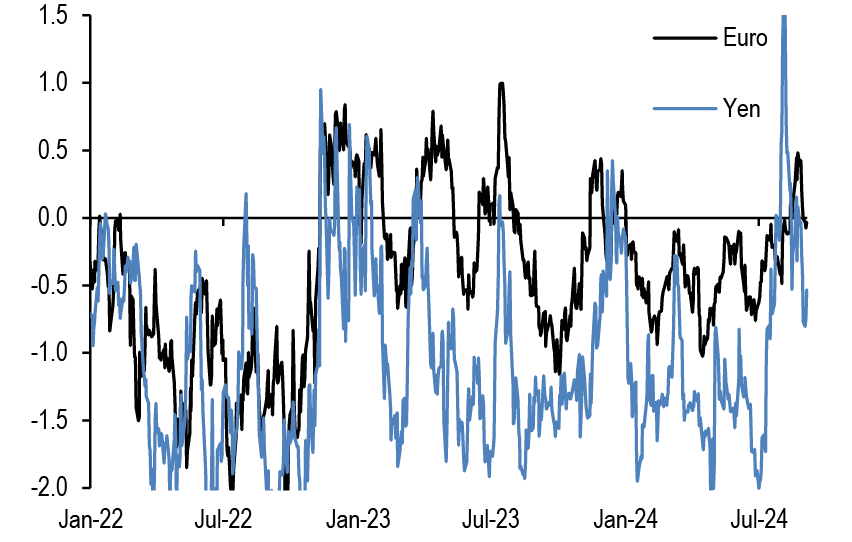
Source: Bloomberg Finance L.P., J.P. Morgan.
Figure 16: Spec Position as a % of Open Interest for yen futures
In %.

Source: Bloomberg Finance L.P., CFTC, J.P. Morgan.
- In all, ahead of this week’s US labor market report, market pricing appears to suggest little US recession risk priced in equities and credit, while bond and commodity markets seem to price in more elevated recession risk. In terms of positioning, we see elevated positioning in equities whether we look at global non-bank investors at the aggregate level or at the investor level, with the exception of momentum-based investors who appear to have more modest longs in the US but are closer to neutral in other regions. Bond positioning does appear somewhat long overall, whether we look at overall non-bank investors or at the institutional investor level. Given that market pricing already looks for Fed funds rates at around 3% by end-2025, which could broadly be characterised as ‘neutral’, long duration positions from here arguably imply more elevated recession risks as rates would need to decline by more than forwards. Depressed commodity positioning is also consistent with higher recession risk.
How large are the rebalancing flows from leveraged ETFs?
- In last week’s publication we looked at Nvidia’s NVDL ETF flows, the world’s largest single stock leveraged ETF. This has raised questions about leveraged ETFs more broadly and the market impact they can have via their capital and rebalancing flows. How large are the rebalancing flows that leveraged ETFs have to do at the end of each trading day? What has their impact been in the most recent weeks?
- Before we answer these questions it is useful to review the nature and the size of this universe. Leveraged and Inverse ETFs provide leveraged long or short exposure to the daily return of an underlying equity index or individual stock. They are used by investors who seek leverage to express either directional views or to hedge existing positions by limiting their liability at the same time. The vast majority of leveraged/inverse ETFs reset their leverage daily. As a result they need to reset or rebalance their exposure on a daily basis in order to drive their leverage back to target levels. They typically place orders near the end of each trading session. This daily resetting, which involves leveraged ETF mechanically buying more of their underlying equity index or stock exposure in up days or selling in down days, in principle amplifies equity market moves towards the end of each trading day.
- To achieve their leverage ratio, these leveraged ETFs typically use total return swaps or futures. Their swap counterparties in turn will hedge these contracts, transmitting the rebalancing flows into markets. As a result, leveraged ETFs are not only subjected to higher liquidity risk by placing orders during a narrow window at the end of the trading day, but also to higher counterparty risk (relative to their unleveraged counterparts who typically own the underlying securities of an index rather than derivative contracts). The lower liquidity of leveraged ETFs can be seen in Figure 17 for QQQ (Invesco Nasdaq100 ETF) and TQQQ (ProShares 3 times Nasdaq100 ETF). TQQQ is the biggest leveraged ETF in the world with AUM of $20bn. Our indirect proxy of ETF liquidity, i.e. the absolute deviation of ETF closing prices from their NAV, is typically higher for the leveraged TQQQ ETF vs its unlevered QQQ counterpart, a reflection of its lower liquidity.
- How big is the size of this industry? The AUM of leveraged and inverse equity ETFs increased sharply over the past decade, from around $40bn in 2015 to around $140bn currently. Around four-fifths represent leveraged ETFs with long equity exposure, with a typical leverage of between 2x and 3x, and only one-fifth represents Inverse leveraged ETFs (i.e. short equity exposure) with typical leverage between -1x and -2x.
- The share of leveraged equity ETFs in trading volumes is higher than their AUM. For example while TQQQ’s AUM is only 7% of the AUM of its unlevered counterpart QQQ, the trading volume ratio of TQQQ over QQQ is around 20%. Their contribution to equity trading is not only confined to their own trading volumes but also includes the trading they generate via their daily resetting or rebalancing. As mentioned above these rebalancing flows act as an amplification force for equity markets as these leveraged ETFs, whether Long or Short, mechanically buy equities at the end of the trading day in up days and sell equities in down days.
- How large are these rebalancing flows? These rebalancing flows of leveraged ETFs are rather deterministic and thus anticipated by market participants. This in turn increases the market risk for leveraged ETFs as it makes them susceptible to predatory trading and frontrunning by other market participants.
-
- where rt is the daily return of the underlying index or stock on which the ETF takes leveraged position on, and L is the leverage ratio that the ETF targets. L is positive for Long exposure ETFs and negative for Inverse ETFs. Plugging into equation (1) the total AUM of leveraged ETFs of $140bn and an average of L2-L of 4 (which corresponds to typical leverage ratio of 2 to 3 for Long and -1 to -2 for Inverse ETFs), we calculate that each percentage point change in equity indices generates around $6bn of rebalancing flow by leveraged ETFs globally. This flow seems modest but becomes more significant if one takes into account that this flow typically reverberates during the last 30 minutes of each trading session. This $6bn rebalancing flow corresponds to one percentage point change in underlying equity indices and its amplification impact would be much bigger in days when equity market changes are more violent and liquidity conditions are typically impaired.
- Admittedly the amplification impact from leveraged ETF rebalancing flows is not always as big as implied by equation (1) because of their own capital flows. This is because capital flows affect the ETF’s AUM and this changes the amount of additional exposure required by the ETF to achieve its target leverage ratio. The dampening impact of capital flows has been highlighted in the academic literature previously, see for example “Are concerns about Leveraged ETFs overblown?”, by Ivanov and Lenkey, Nov 2014. In particular, formula (1) changes and takes the following form in the case of a daily capital inflow:
-
- i.e. a negative capital flow ft reduces the amount of rebalancing a leveraged ETF needs to do in an up day, while a positive flow reduces the amount of rebalancing needed in a down day. In other words, contrarian capital flows can mitigate the potential for leveraged ETFs to amplify market volatility. Such contrarian flows occurred in the most recent equity market correction, as shown in Figure 18. For example on September 3rd during an intense equity correction, we estimate that leveraged and inverse ETFs had to sell $14.5bn of underlying equity exposures, but investors injected $1.5bn during that day, thus offsetting some of the rebalancing flow. However, during days when the equity market rebounded sharply i.e. July 22nd , capital flows acted as an amplifier rather than a dampener, i.e. capital inflows meant that during that day leveraged ETFs had to buy $3.4bn more than the rebalancing flows of $8.5bn. In general , during days when equities are significantly lower, capital inflows tend to mitigate the rebalancing-related equity selling of leveraged ETFs, while during days when equities are significantly higher, capital inflows tend to amplify the rebalancing-related equity buying of leveraged ETFs.
- In all, with the AUM of leveraged and inverse ETFs having grown sharply over the past decade, the amplification impact of their rebalancing flows can be very significant on days with sharp equity moves, even if at times these rebalancing flows are somewhat mitigated by contrarian capital flows.
Figure 17: Average absolute daily deviation of the ETF closing price from Net Asset Value for TQQQ and QQQ US Equity ETFs
21-day moving average, annualized.

Source: Bloomberg Finance L.P., J.P. Morgan.
Figure 18: Leveraged and Inverse equity ETFs estimated daily rebalancing flow vs. capital flow
$bn per day, based on the estimated daily rebalancing flow for the biggest leveraged and inverse equity ETFs with total AUM of $91bn vs $138bn for all leveraged long and inverse equity ETFs. We use Equation (1) to calculate the daily rebalancing flow for each ETF separately and then aggregate across all ETFs.

Source: Bloomberg Finance L.P., J.P. Morgan.
Appendix
Chart A1: Global equity & bond fund flows
$bn per year of Net Sales, i.e. includes net new sales + reinvested dividends for Mutual Funds and ETFs globally, i.e. for funds domiciled both inside and outside the US. Flows come from ICI (worldwide data up to Q1’24). Data since then are a combination of monthly and weekly data from Lipper, EPFR and ETF flows from Bloomberg Finance L.P.
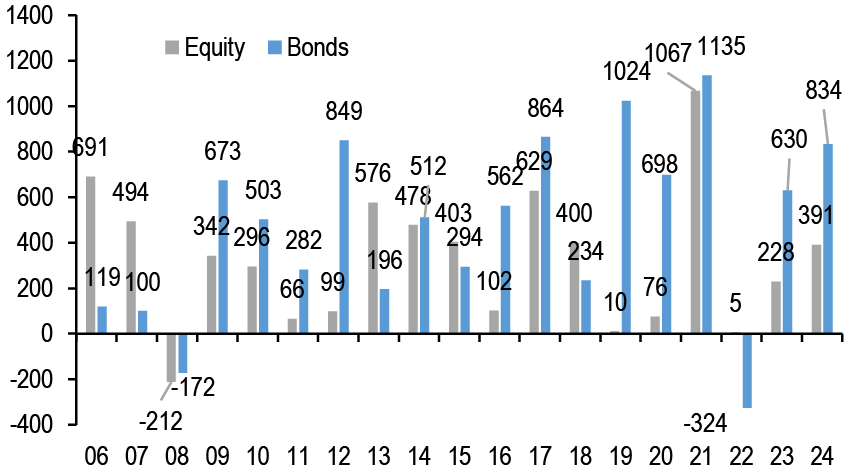
Source: ICI, EPFR, Lipper, Bloomberg Finance L.P., J.P. Morgan.
Chart A2: Fund flow indicator
Difference between flows into Equity and Bond funds: $bn per week. Difference between flows into Equity vs. Bond funds in $bn per week. Flows include Mutual Fund and ETF flows globally, i.e. funds domiciled both inside and outside the US (source: EPFR) The thin blue line shows the 4-week average of difference between Equity and Bond fund flows. Dotted lines depict ±1 StDev of the blue line. The thick black line shows a smoothed version of the same series. The smoothing is done using a Hodrick-Prescott filter with a Lambda parameter of 100.

Source: EPFR, J.P. Morgan.
Table A1: Flow Monitor
$bn per week. The first two rows include Mutual Fund and ETF flows globally, i.e.flows for funds domiciled both inside and outside the US(source: EPFR). The last four rows only include funds domiciled in the US.International Equity funds are equity funds domiciled in the US that invest outside the US (source: ICI and Bloomberg Finance L.P.).
| MF & ETF Flows | 21-Aug | 4 wk avg | 13 wk avg | 2024 avg |
| All Equity | 20.36 | 12.6 | 15.0 | 10.8 |
| All Bond | 15.07 | 11.5 | 12.5 | 12.0 |
| US Equity | 4.27 | -4.5 | -1.9 | -3.9 |
| US Bonds | 4.62 | 2.7 | 5.0 | 6.9 |
| Non-US Equity | 16.09 | 17.1 | 16.8 | 14.5 |
| Non-US Bonds | 10.45 | 8.8 | 7.5 | 4.6 |
| US Taxable Bonds | 9.10 | 6.4 | 6.4 | 4.9 |
| US Municipal Bonds | 0.22 | 0.2 | 0.2 | 0.1 |
| US HG Bonds | 4.85 | 3.5 | 3.6 | 4.2 |
| US HY Bonds | 1.49 | -0.7 | 0.1 | 0.3 |
| US MMFs | 10.20 | 16.1 | 9.3 | 9.6 |
| UCITS Flows | May-24 | 3 mth avg | 2023 avg | 2024 avg |
| Euro MMFs | -13.13 | 2.08 | 15.63 | 4.06 |
| Euro Equities | 28.53 | 8.7 | 0.6 | 7.7 |
| Euro Bonds | 22.24 | 23.5 | 12.3 | 28.5 |
Source: ICI, EPFR, EFAMA, Bloomberg Finance L.P., and J.P. Morgan.
Table A2: Trading turnover monitor
Volumes are monthly and Turnover ratio is annualised (monthly trading volume annualised divided by the amount outstanding). UST Cash is primary dealer transactions in all US government securities. UST futures are from Bloomberg Finance L.P. JGBs are OTC volumes in all Japanese government securities. Bunds, Gold, Oil and Copper are futures. Gold includes Gold ETFs. Min-Max chart is based on Turnover ratio. For Bunds and Commodities, futures trading volumes are used while the outstanding amount is proxied by open interest. The diamond reflects the latest turnover observation. The thin blue line marks the distance between the min and max for the complete time series since Jan-2005 onwards. Y/Y change is change in YTD notional volumes over the same period last year.

Source: Bloomberg Finance L.P., Federal Reserve, Trace, Japan Securities Dealer Association, WFE, J.P. Morgan.
ETF Flow Monitor (as of 4th Sep)
Chart A3: Global Cross Asset ETF Flows
Cumulative flow into ETFs as a % of AUM

Source: Bloomberg Finance L.P., J.P. Morgan.
Chart A4: Bond ETF Flows
Cumulative flow into bond ETFs as a % of AUM

Source: Bloomberg Finance L.P., J.P. Morgan.
Chart A5: Global Equity ETF Flows
Cumulative flow into global equity ETFs as a % of AUM

Source: Bloomberg Finance L.P., J.P. Morgan. Note: We include ETFs with AUM > $200mn in all the flow monitor charts. Chart A5 exclude China On-shore (A-share) ETFs from EM and in Japan. We subtract the BoJ buying of ETFs.
Chart A6: Equity Sectoral and Regional ETF Flows
Rolling 3-month and 12-month change in cumulative flows as a % of AUM. Both sorted by 12-month change

Source: Bloomberg Finance L.P., J.P. Morgan.
Short Interest Monitor
Chart A7: Short interest on the EEM and EMB US ETF
Short Interest as a % share of share outstanding.

Source: S3, J.P. Morgan
Chart A9: Short interest on the SPY and QQQ US ETF
Short Interest as a % share of share outstanding. Last obs is for 20th August 2024.

Source: S3, J.P. Morgan
Chart A8: Short interest on the LQD and HYG US ETF
Short Interest as a % share of share outstanding.

Source: S3, J.P. Morgan
Chart A10: S&P500 sector short interest
Short interest as a % of shares outstanding based on z-scores. A strategy which overweights the S&P500 sectors with the highest short interest z-score (as % of shares o/s) vs. those with the lowest, produced an information ratio of 0.7 with a success rate of 56% (see F&L, Jun 28,2013 for more details).

Source: NYSE, Bloomberg Finance L.P., J.P. Morgan
Chart A11a: Cross Asset Volatility Monitor 3m ATM Implied Volatility (1y history), as of 27th Aug-2024
This table shows the richness/cheapness of current three-month implied volatility levels (red dot) against their one-year historical range (thin blue bar) and the ratio to current realised volatility. Assets with implied volatility outside their 25th/75th percentile range (thick blue bar) are highlighted. The implied-to-realised volatility ratio uses 3-month implied volatilities and 1-month (around 21 trading days) realised volatilities for each asset.


Chart A11b: Option skew monitor
Skew is the difference between the implied volatility of out-of-the-money (OTM) call options and put options. A positive skew implies more demand for calls than puts and a negative skew, higher demand for puts than calls. It can therefore be seen as an indicator of risk perception in that a highly negative skew inequities is indicative of a bearish view. The chart shows z-score of the skew, i.e. the skew minus a rolling 2-year avg skew divided by a rolling two-year standard deviation of the skew. A negative skew on iTraxx Main means investors favour buying protection, i.e. a short risk position. A positive skew for the Bund reflects a long duration view, also a short risk position.

Source: J.P. Morgan.
Chart A11c: Equity-Bond metric map
Explanation of Equity - Bond metric map: Each of the five axes corresponds to a key indicator for markets. The position of the blue line on each axis shows how far the current observation is from the extremes at either end of the scale. For example, a reading at the centre for value would mean that risky assets are the most expensive they have ever been while a reading at the other end of the axis would mean they are the cheapest they have ever been. Overall, the larger the blue area within the pentagon, the better for the risky markets. All variables are expressed as the percentile of the distribution that the observation falls into. I.e. a reading in the middle of the axis means that the observation falls exactly at the median of all historical observations. Value: The slope of the risk-return trade-off line calculated across USTs, US HG and HY corporate bonds and US equities(see GMOS p. 6, Loeys et al, Jul 6 2011 for more details). Positions: Difference between net spec positions on US equities and intermediate sector UST. See Chart A13. Flow momentum: The difference between flows into equity funds (incl. ETFs) and flows into bond funds. Chart A1. We then smooth this using a Hodrick-Prescott filter with a lambda parameter of 100. We then take the weekly change in this smoothed series as shown in Chart A1. Economic momentum:The 2-month change in the global manufacturing PMI. (See REVISITING: Using the Global PMI as trading signal, Nikolaos Panigirtzoglou, Jan 2012). Equity price momentum: The 6-month change in the S&P500 equity index. As of 23rd Aug 24.

Source: Bloomberg Finance L.P., J.P. Morgan.
Spec position monitor
Chart A12: Weekly Spec Position Monitor
Net spec positions are proxied by the number of long contracts minus the number of short contracts using the speculative category of the Commitments of Traders reports (as reported by CFTC). To proxy for speculative investors for equity and US Treasury bond futures positions we use Asset managers and leveraged funds (see Chart A13), whereas for other assets we use the legacy Non-Commercial category. This net position is then converted to a dollar amount by multiplying by the contract size and then the corresponding futures price. We then scale the net positions by open interest. The chart shows the z-score of these net positions. US rates is a duration-weighted composite of the individual UST futures contracts excluding the Eurodollar contract.

Source: Bloomberg Finance L.P., CFTC, J.P. Morgan
Chart A14: Spec position indicator on Risky vs. Safe currencies
Difference between net spec positions on risky & safe currencies. Net spec position is calculated in USD across 5 ‘risky’ and 3 ‘safe’ currencies (safe currencies also include Gold). These positions are then scaled by open interest and we take an average of ‘risky’ and ‘safe’ assets to create two series. The chart is then simply the difference between the“risky” and “safe” series. The final series shown in the chart below is demeaned using data since 2006. The risky currencies are: AUD, NZD,CAD, MXN and BRL. The safe currencies are: JPY, CHF and Gold.

Source: Bloomberg Finance L.P., CFTC, J.P. Morgan.
Chart A13: Positions in US equity futures by Asset managers and Leveraged funds
CFTC positions in US equity futures by Leveraged funds and Asset managers (as a % of open interest). It is an aggregate of the S&P500, DowJones, NASDAQ and their Mini futures contracts.

Source: CFTC, Bloomberg Finance L.P. and J.P. Morgan
Chart A15: Spec position indicator on US equity futures vs. intermediate sector UST futures
Difference between net spec positions on US equity futures vs.intermediate sector UST futures. This indicator is derived by the difference between total CFTC positions in US equity futures by Asset managers + Leveraged Funds scaled by open interest minus the Asset managers + Leveraged Funds spec position on intermediate sector UST futures (i.e. all UST futures duration weighted ex ED and ex 2Y UST futures) also scaled by open interest.

Source: CFTC, Bloomberg Finance L.P. and J.P. Morgan
Mutual fund and hedge fund betas
Chart A16: 21-day rolling beta of 20 biggest active US bond mutual fund managers with respect to the US Agg Bond Index
The dotted line shows the average beta since 2013.

Source: Bloomberg Finance L.P., J.P. Morgan.
Chart A17: 21-day rolling beta of 20 biggest active Euro bond mutual fund managers with respect to the Euro Agg Bond Index
The dotted line shows the average beta since 2013.

Source: Bloomberg Finance L.P., J.P. Morgan.
Chart A18: Performance of various type of investors
The table depicts the performance of various types of investors in % as of 2nd Sept 2024.
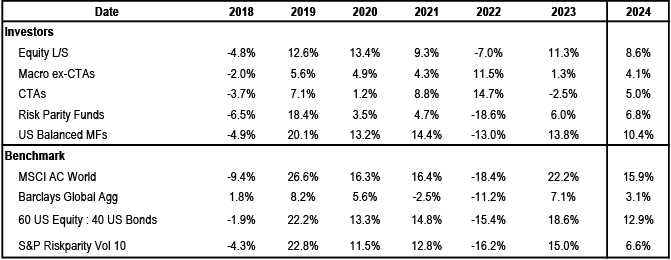
Source: Bloomberg Finance L.P., HFR, Pivotal Path, J.P. Morgan.
Chart A19: Momentum signals for 10Y UST and 10Y Bunds
Average z-score of Short- and Long-term momentum signal in our Trend Following Strategy framework shown in Tables A3 and A4 below in the Appendix
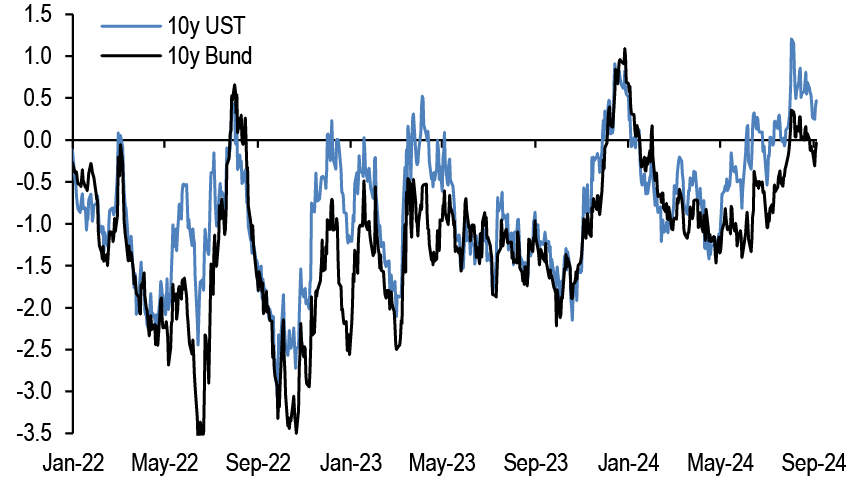
Source: Bloomberg Finance L.P., J.P. Morgan.
Chart A20: Momentum signals for S&P500
Average z-score of Short- and Long-term momentum signal in our Trend Following Strategy framework shown in Tables A3 and A4 below in the Appendix.

Source: Bloomberg Finance L.P., J.P. Morgan.
Chart A21: Equity beta of US Balanced Mutual funds and Risk Parity funds
Rolling 21-day equity beta based on a bivariate regression of the daily returns of our Balanced Mutual fund and Risk Parity fund return indices to the daily returns of the S&P 500 and BarCap US Agg indices. Given that these funds invest in both equities and bonds we believe that the bivariate regression will be more suitable for these funds. Our risk parity index consists of 25 daily reporting Risk Parity funds. Our Balanced Mutual fund index includes the top 20 US-based active funds by assets and that have existed since 2006. Our Balanced Mutual fund index has a total AUM of$700bn, which is around half of the total AUM of $1.5tr of US based Balanced funds which we believe to be a good proxy of the overall industry It excludes tracker funds and funds with a low tracking error. Dotted lines are average since 2015.

Source: Bloomberg Finance L.P., J.P. Morgan.
Chart A22: Equity beta of monthly reporting Equity Long/Short hedge funds
Proxied by the ratio of the monthly performance of Pivotal Path Asset-Weighted Equity Hedge fund index divided by the monthly performance of MSCI ACWorld Index.

Source: Bloomberg Finance L.P., Pivotal Path, J.P. Morgan
Chart A23: USD exposure of currency hedge funds
The net spec position in the USD as reported by the CFTC. Spec is the non-commercial category from the CFTC.

Source: CFTC, Barclay, Datastream, Bloomberg Finance L.P., J.P. Morgan.
CTAs – Trend following investors’ momentum indicators
Table A3: Simple return momentum trading rules across various commodities
Optimal look-back period of each momentum strategy combined with a mean reversion indicator that turns signal neutral when momentum z-score more than 1.5 standard deviations above or below mean, and a filter that turns neutral when the z-score is low (below 0.05 and above -0.05) to avoid excessive trading. Look-backs, current signals and z-scores are shown for shorter-term and longer-term momentum separately, along with performance of a combined signal. Annualised return, volatility and information ratio of the signal; current signal; and z-score of the current return over the relevant look-back period; data from 1999 onward.

Source: Bloomberg Finance L.P., J.P. Morgan calculations.
Table A4: Simple return momentum trading rules across international equity indices, bond futures and FX
Optimal look-back period of each momentum strategy combined with a mean reversion indicator that turns signal neutral when momentum z-score more than 1.5 standard deviations above or below mean, and a filter that turns neutral when the z-score is low (below 0.05 and above -0.05) to avoid excessive trading. Look-backs, current signals and z-scores are shown for shorter-term and longer-term momentum separately, along with performance of a combined signal. Annualised return, volatility and information ratio of the signal; current signal; and z-score of the current return over the relevant look-back period; data from 1999 onward.
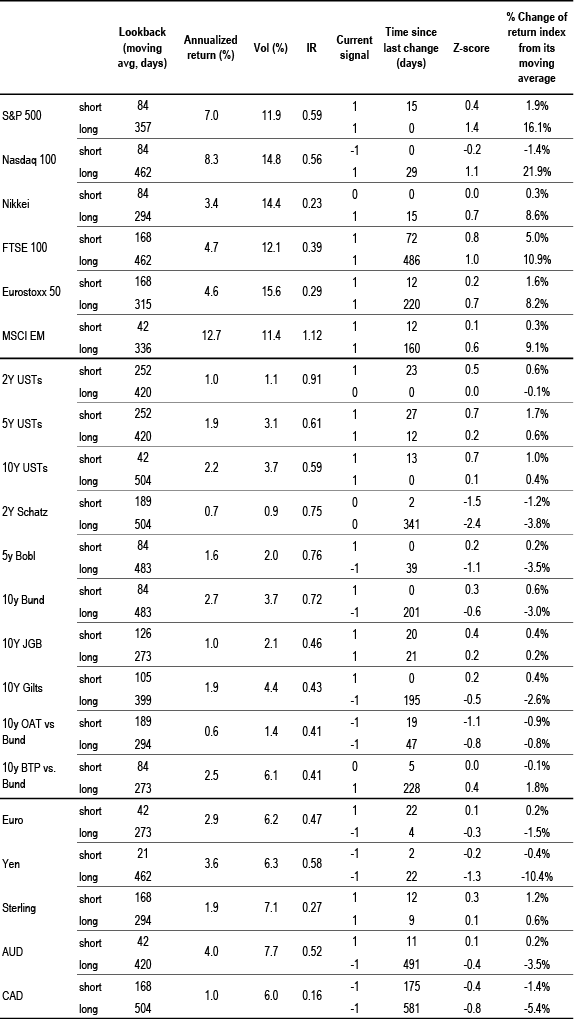
Source: Bloomberg Finance L.P., J.P. Morgan calculations.
Corporate Activity
Chart A24: G4 non-financial corporate capex and cash flow as % of GDP
% of GDP, G4 includes the US, the UK, the Euro area and Japan. Last observation as of Q4 2023.

Source: ECB, BOJ, BOE, Federal Reserve flow of funds, J.P. Morgan.
Chart A25: G4 non-financial corporate sector net debt and equity issuance
$tr per quarter, G4 includes the US, the UK, the Euro area and Japan. Last observation as of Q4 2023.

Source: ECB, BOJ, BOE, Federal Reserve flow of funds, J.P. Morgan.
Chart A26: Global M&A and LBO
$tr. M&A and LBOs are announced.

Source: Dealogic, J.P. Morgan.
Chart A27: US and non-US share buyback
$bn, are as of August’24. Buybacks are announced.

Source: Bloomberg Finance L.P., Thomson Reuters, J.P. Morgan
Pension fund and insurance company flows
Chart A28: G4 pension funds and insurance companies equity and bond flows
Equity and bond buying in $bn per quarter. G4 includes the US, the UK,Euro area and Japan. Last observation is Q1 2024.

Source: ECB, BOJ, BOE, Federal Reserve flow of funds, J.P. Morgan.
Chart A29: G4 pension funds and insurance companies equity and bond levels
Equity and bond as % of total assets per quarter. G4 includes the US, the UK, Euro area and Japan. Last observation is Q1 2024.

Source: ECB, BOJ, BOE, Federal Reserve flow of funds., J.P. Morgan
Chart A30: Pension fund deficits
US$bn. For US, funded status of the 100 largest corporate defined benefit pension plans, from Milliman. For UK, funded status of the defined benefit schemes eligible for entry to the Pension Protection Fund, converted to US$ at today’s exchange rates.
Last obs. is July’24 for US & UK.
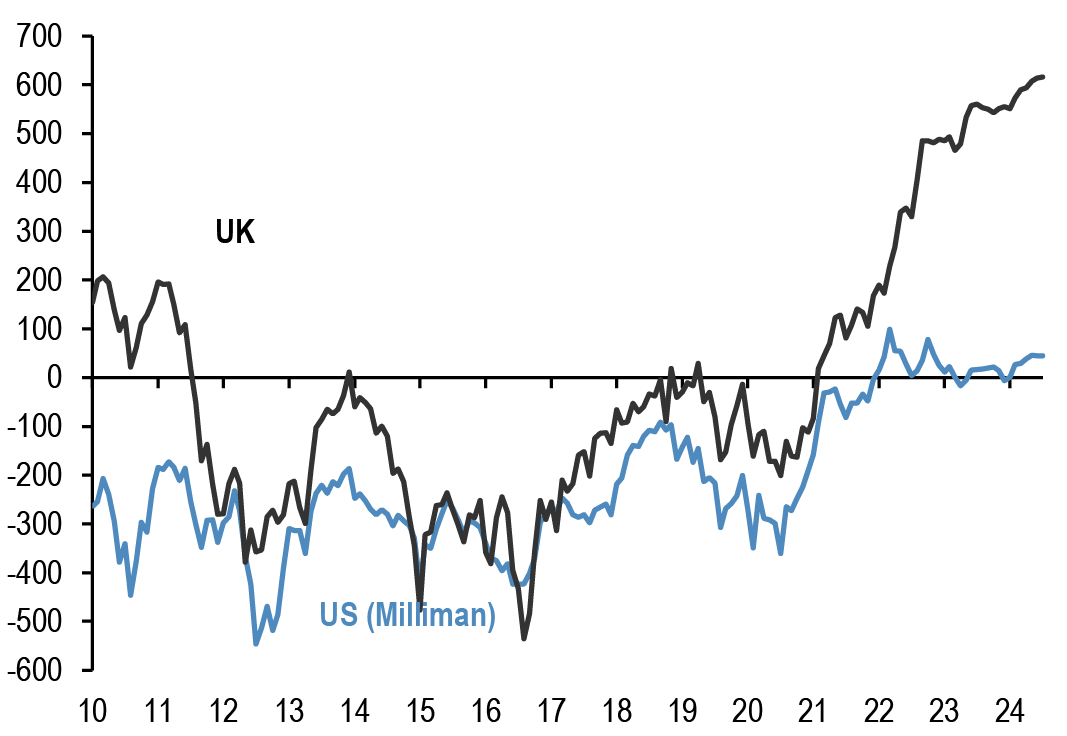
Source: Milliman, UK Pension Protection Fund, J.P. Morgan.
Chart A31: G4 pension funds and insurance companies cash and alternatives levels
Cash and alternative investments as % of total assets per quarter. G4 includes the US, the UK, Euro area and Japan. Last observation is Q1 2024.

Source: ECB, BOJ, BOE, Federal Reserve flow of funds, J.P. Morgan.
Credit Creation
Chart A32: Credit creation in the US, Japan and Euro area
Rolling sum of 4-quarter credit creation as % of GDP. Credit creation includes both bank loans as well as net debt issuance by non-financial corporations and households. Last obs. is Q1’24 for Japan, Euro Area and US.
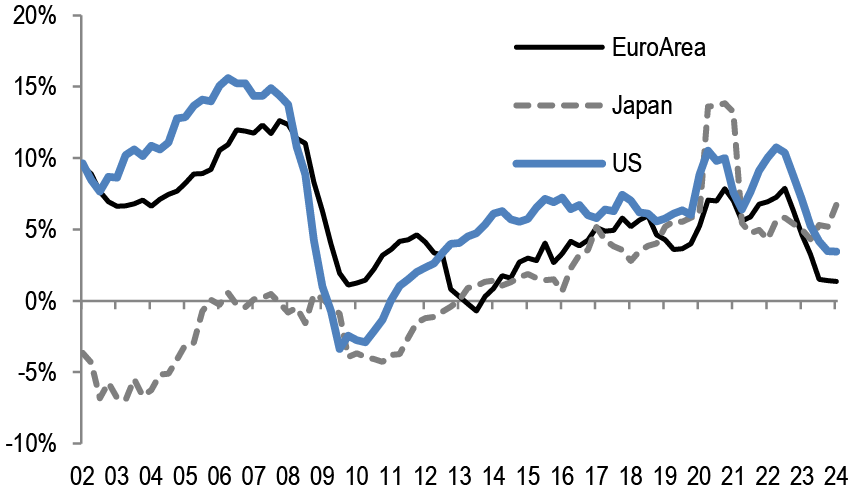
Source: Fed, ECB, BoJ, Bloomberg Finance L.P., and J.P. Morgan calculations.
Chart A33: Credit creation in EM
Rolling sum of 4-quarter credit creation as % of GDP. Credit creation includes both bank loans as well as net debt issuance by non-financial corporations and households. Last obs. is for Q4’23.

Source: G4 Central banks FoF, BIS, ICI, Barcap, Bloomberg Finance L.P., IMF, and J.P.Morgan calculation
Chart A34: Monthly net issuance of US HG bonds
$bn. May 2024.

Source: Dealogic, J.P. Morgan
Table A5: Equity and Bond issuance
$bn, Equity supply and corporate announcements are based on announced deals, not completed. M&A is announced deal value and buybacks are announced transactions. Y/Y change is change in YTD announcements over the same period last year.

Source: Bloomberg Finance L.P., Dealogic, Thomson Reuters, J.P. Morgan.
Bitcoin monitor
Chart A35: Our Bitcoin position proxy based on open interest in CME Bitcoin futures contracts
In number of contracts. Last obs. for 4th September 2024.
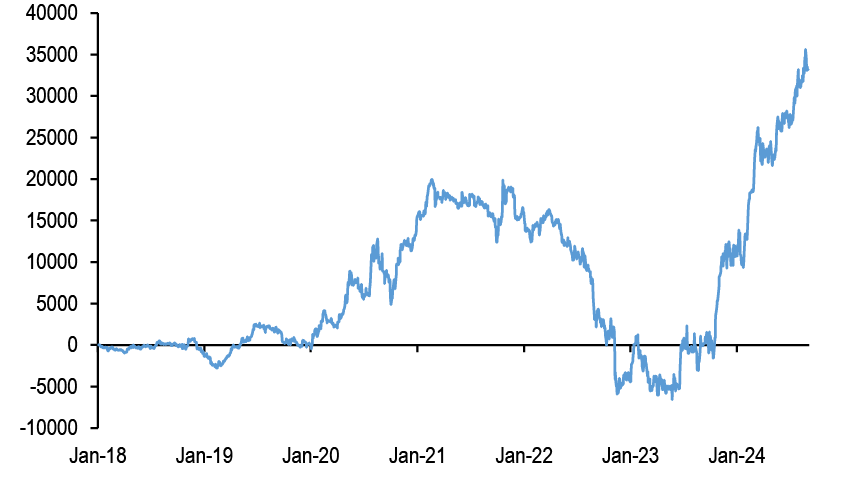
Source: Bloomberg Finance L.P., J.P. Morgan
Chart A36: Cumulative Flows in all Bitcoin funds and Gold ETF holdings
Both the y-axis in $bn.

Source: Bloomberg Finance L.P., J.P. Morgan.
Chart A37: Ratio of bitcoin market price to production cost
Based on the cost of production approach following Hayes (2018).

Source: Bitinfocharts, J.P. Morgan
Chart A38: Flow pace into publicly-listed bitcoin funds including bitcoin ETFs
$mm per week, 4-week rolling average flow.

Source: Bloomberg Finance L.P., J.P. Morgan.
Japanese flows and positions
Chart A39: Tokyo Stock Exchange margin trading: total buys minus total sells
In bn of shares. Topix on right axis.

Source: Tokyo Stock Exchange, Bloomberg Finance L.P., J.P. Morgan.
Chart A40: Monthly net purchases of Japanese bonds and Japanese equities by foreign residents
$bn, Last weekly obs. is for 23rd Aug’ 24.
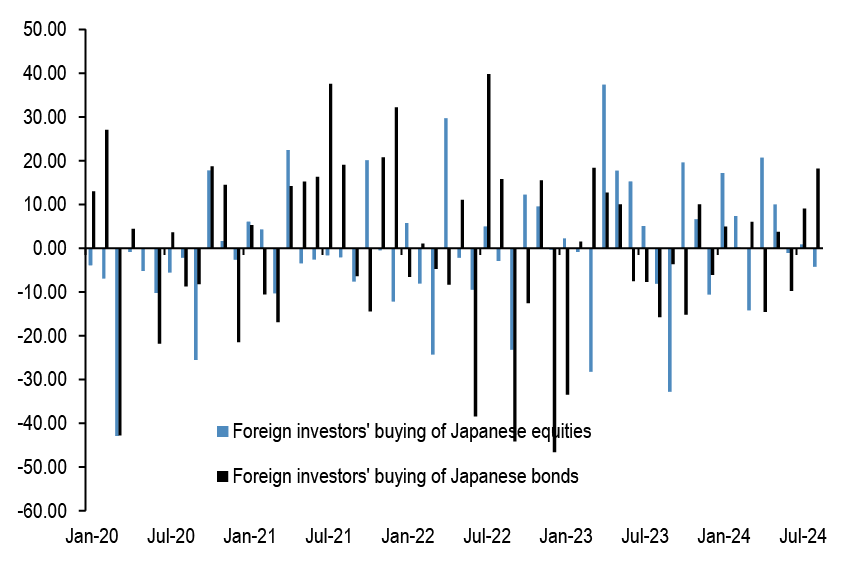
Source: Japan MoF, Bloomberg Finance L.P., and J.P. Morgan.
Chart A41: Monthly net purchases of foreign bonds and foreign equities by Japanese residents
$bn, Last weekly obs. is for 23th Aug’ 24.

Source: Japan MoF, Bloomberg Finance L.P., and J.P. Morgan.
Chart A42: Overseas CFTC spec positions
CFTC spec positions are in $bn. For Nikkei we use CFTC positions in Nikkei futures (USD & JPY) by Leveraged funds and Asset managers.

Source: Bloomberg Finance L.P., CFTC, J.P. Morgan calculations.
Commodity flows and positions
Chart A43: Gold spec positions
$bn. CFTC net long minus short position in futures for the Managed Money category.

Source: CFTC, Bloomberg Finance L.P., J.P. Morgan.
Chart A44: Gold ETFs
Mn troy oz. Physical gold held by all gold ETFs globally.

Source: Bloomberg Finance L.P., J.P. Morgan.
Chart A45: Oil spec positions
Net spec positions divided by open interest. CFTC futures positions for WTI and Brent are net long minus short for the Managed Money category.

Source: CFTC, Bloomberg Finance L.P., J.P. Morgan.
Chart A46: Energy ETF flows
Cumulative energy ETFs flow as a % of AUM. MLP refers to the Alerian MLP ETF.

Source: CFTC, Bloomberg Finance L.P., J.P. Morgan.
Corporate FX hedging proxies
Chart A47: Average beta of Eurostoxx 50 companies and Eurostoxx Mid-Cap to trade-weighted EUR
Rolling 26 weeks average betas based on a bivariate regression of the weekly returns of individual stocks in the Eurostoxx 50 index to the weekly returns of the MSCI AC World and JPM EUR Nominal broad effective exchange rate (NEER).

Source: Bloomberg Finance L.P., J.P. Morgan
Chart A48: Average beta of S&P500 companies to trade-weighted US dollar
Rolling 26 weeks average betas based on a bivariate regression of the weekly returns of stocks in the S&P500 index to the weekly returns of the MSCI AC World and JPM USD Nominal broad effective exchange rate(NEER).

Source: Bloomberg Finance L.P., J.P. Morgan
Chart A49: Average beta of FTSE 100 companies to trade-weighted GBP
Rolling 26 weeks average betas based on a bivariate regression of the weekly returns of individual stocks in the FTSE 100 index to the weekly returns of the MSCI AC World and JPM GBP Nominal broad effective exchange rate (NEER).
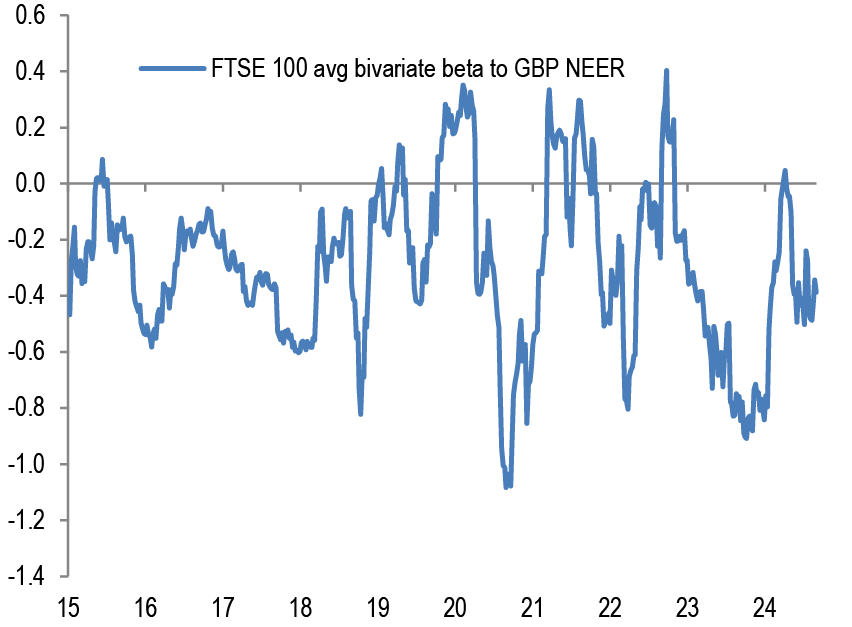
Source: Bloomberg Finance L.P., J.P. Morgan
Chart A50: Average beta of MSCI EM companies to trade-weighted EM Currency Index
Rolling 26 weeks average betas based on a bivariate regression of the weekly returns of individual stocks in the MSCI EM index to the weekly returns of the MSCI AC World and JPM EM Nominal broad effective exchange rate (NEER).

Source: Bloomberg Finance L.P., J.P. Morgan
Non-Bank investors’ implied allocations
Chart A51: Implied equity allocation by non-bank investors globally
Global equities as % total holdings of equities/bonds/M2 by non-bank investors. Dotted lines are averages.

Source: Bloomberg Finance L.P., J.P. Morgan
Chart A52: Implied bond allocation by non-bank investors globally
Global bonds as % total holdings of equities/bonds/M2 by non-bank investors. Dotted lines are averages.

Source: Bloomberg Finance L.P., J.P. Morgan
Chart A53: Implied cash allocation by non-bank investors globally
Global cash held by non-bank investors as % total holdings of equities/bonds/M2 by non-bank investors. Dotted lines are averages.

Source: Bloomberg Finance L.P., J.P. Morgan
Chart A54: Implied commodity allocation by non-bank investors globally
Proxied by the open interest of commodity futures ex gold as % of the stock of equities, bonds and cash held by non-bank investors globally.
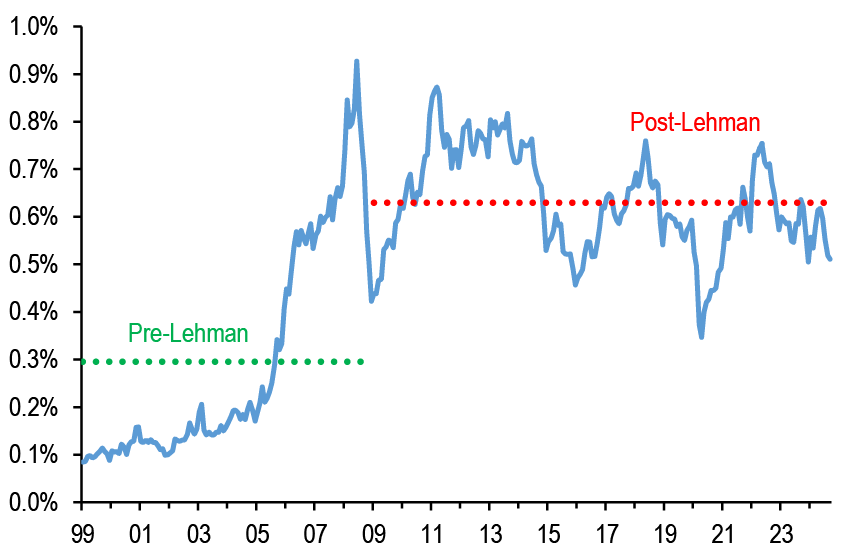
Source: Bloomberg Finance L.P., J.P. Morgan

